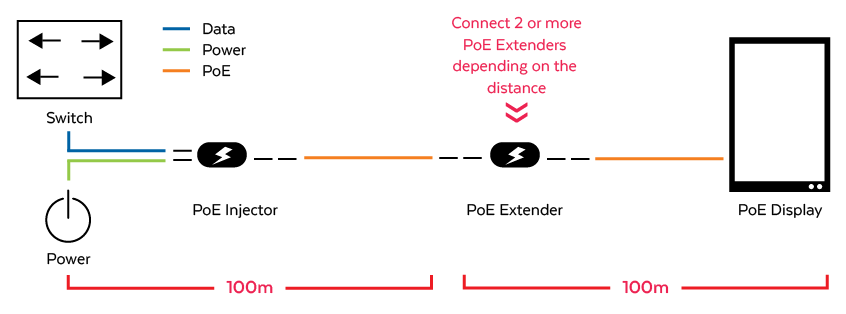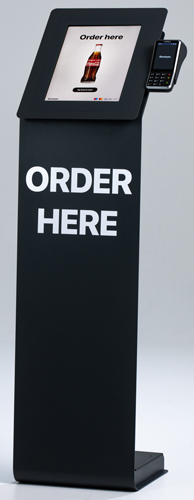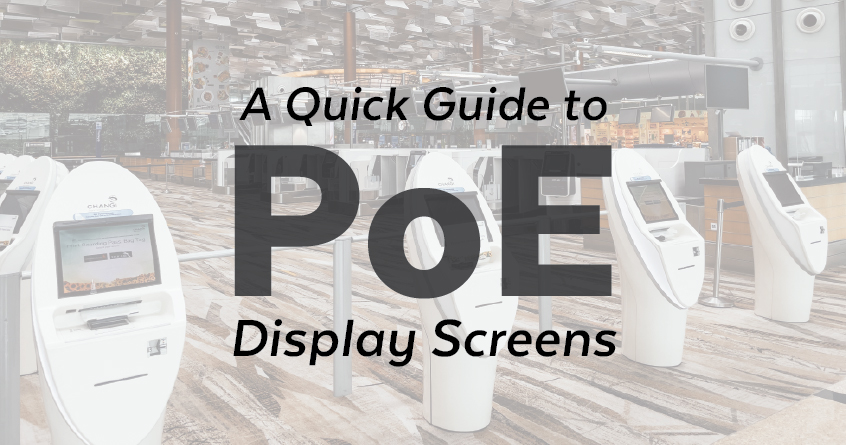In the fast-paced world of networking and technology, Power over Ethernet (PoE) has emerged as a game-changing solution. PoE technology allows power and data to be transmitted simultaneously over a single Cat6 Ethernet cable, simplifying installations and reducing costs. One practical way to leverage this agility is through the use of PoE display screens and classic kiosks and their use in various industries.
What Is a PoE Display Screen?
PoE display screens are a cutting-edge technology that combines the power of network connectivity with versatile display capabilities. The single cable installation model makes them a viable solution for numerous applications across a campus, retail outlet, convention center, or historic building without significant impact on a building or property infrastructure.
What Does a Display Screen Do?
A PoE display screen is an essential tool for communication across all sectors. The display screen’s primary function is visually presenting information or content to an audience. Their versatility makes them suitable for various applications, such as advertisements, menus, timetables, and interactive content.
How Is It Different from a Computer Monitor?
Although PoE display screens may look similar to computer monitors, they are designed to perform specific tasks more efficiently. A computer monitor is primarily designed for viewing content from a connected computer or device. In contrast, a display screen is intended for showcasing information, advertising, entertainment, and industrial applications.
Unlike traditional computer monitors, PoE display screens are engineered to be remotely managed, ensuring that content can be updated and controlled from a central location. They are also designed to withstand constant use, making them ideal for public spaces.
What Is Power over Ethernet (PoE)?
Because PoE technology allows electrical power and data to transmit simultaneously over Ethernet cables, it simplifies network installations. Combining power and data cables into one eliminates the need for additional outlets and thus gives access to a wider range of installers, such as IT administrators, facilities managers, and general contractors.
PoE is commonly used to power devices like IP cameras, access points, and, of course, PoE display screens.
PoE technology has gained broad acceptance across various industries, where it plays a vital role in improving network connectivity and streamlining the deployment of powered devices (PDs). This feature has allowed PoE to become an essential element of contemporary network and energy management solutions.
How Does PoE Simplify Powered Device (PD) Deployments?
PoE simplifies the deployment of Powered Devices (PDs), enabling PDs to be efficiently and cost-effectively connected. This simplification saves time and resources, ensuring a more efficient and manageable network infrastructure.
Easier Remote Installations
One of the standout advantages of PoE technology is its facilitation of easier remote installations. With a single Cat6 cable, PoE enables the setup of Powered Devices (PDs) in locations that may be hard to reach or require frequent updates. This capability means PoE is more convenient and allows for greater flexibility in deploying PDs across various environments and industries.
Without the use of a PoE extender, power and data can travel up to 329 feet (100 meters). With an extender, also known as a repeater, power and data can travel significantly farther over a Cat6 cable or above. Fiber can extend even further but can only deliver data and not power, making a local power source necessary.
 What Is a Kiosk?
What Is a Kiosk?
A kiosk or booth is a self-contained, interactive, and often freestanding terminal or display unit designed for specific tasks or information dissemination. Kiosks typically feature touchscreens, keyboards, or other input methods that allow users to access and interact with various services, such as information retrieval, ticket purchasing, self-checkout, or wayfinding.
Where Are Kiosks Used?
PoE-enabled classic kiosks find applications in an impressive array of sectors, offering tailored solutions to meet specific industry needs:
- Theme Parks: In theme parks, booths are the go-to source for up-to-date information, including park maps, ride schedules, and ticket purchasing options. PoE display screens ensure visitors have the latest information at their fingertips, enhancing their overall experience.
- Office Parks: Office parks use classic kiosks as directories, providing visitors and employees with vital information about the location of businesses and services within the park. With PoE technology, these stands remain operational and require less maintenance.
- Resorts: Resorts employ classic kiosks to display activity schedules, maps, and emergency information, ensuring that guests can access real-time updates and essential information during their stay.
- Transportation Hubs: At airports, train stations, and bus terminals, classic kiosks offer travelers timetables, wayfinding information, and transportation options. PoE ensures uninterrupted service, even in high-traffic areas.
- Academic Institutions: Campuses typically use classic kiosks to showcase class schedules, campus maps, and event information. With PoE technology, installing kiosks becomes much more manageable.
- Casinos: Classic kiosks in casinos provide players with essential information like player rewards, wayfinding, and event schedules. PoE display screens guarantee that visitors are well-informed during their visit.
- Municipal Departments: Government departments, including the Department of Motor Vehicles (DMV), utilize classic kiosks for offering information about services, queue management, and document printing. PoE technology ensures the smooth operation of these essential services.
- Retailers: Retailers often deploy classic kiosks for self-checkout, price checking, and advertising. PoE display screens guarantee that these kiosks always stay online and operational, facilitating smooth experiences for customers.
- Museums: In museums and parks, classic kiosks provide an educational experience for visitors. They deliver information about exhibits, showcase interactive content, and offer maps. PoE technology enhances the visitor experience by keeping information current and accessible.
Classic kiosks powered by PoE technology can be customized to meet specific needs, making them valuable in many environments. PoE booths offer organizations an efficient way of connecting with their customers and visitors, delivering a blend of information, services, and interactive experiences. Organizations can ensure a reliable and cost-effective solution for their information and interactive display needs by choosing suitable PoE screens for classic kiosks.
Unleashing the Power of PoE Display Screens for Modern Solutions
The evolution of Power over Ethernet (PoE) technology has ushered in a new era of convenience and cost-effectiveness for display screens. PoE display screens, particularly when integrated into classic kiosks, offer a versatile solution for businesses and institutions. With a single Cat6 cable delivering power and data, traditional booths become a practical and efficient means of providing information, advertising, and interactive experiences. In a nutshell, PoE technology simplifies deployments, lowers costs, and ensures that information remains up-to-date.
As technology advances, PoE display screens and classic kiosks are poised to play an even more significant role in shaping how we interact with information and services in public spaces. This versatility makes them a valuable asset for any organization seeking to engage with its audience. Learn more about PoE technology at Versa Technology.

